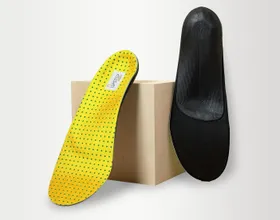5 Exercises for Morton's Neuroma: Alleviate Your Foot Pain
Updated August 24, 2025

Have you ever felt like there's a pebble in your shoe when there's nothing there? This could be a symptom of Morton's Neuroma, a common foot condition that results in a thickening of the tissue around one of the nerves leading to your toes. This thickening can cause sharp, burning pain on the ball of your foot.
Morton’s Neuroma is typically caused by entrapment of the common digital plantar nerves as they pass between the long bones of the foot. This entrapment may be due to wearing narrow shoes or high heels, or engaging in repetitive activities like running and jumping that put pressure on the forefoot.
While treatment options for Morton's Neuroma range from activity modification and anti-inflammatory medications to more severe interventions such as corticosteroid injections or even surgery, there are exercises you can try at home that could help alleviate the pain.
5 Exercises for Morton's Neuroma
- Standing Calf Stretch
- Foot Roll
- Towel Curls
- Plantar Fascia Stretch
- Seated Soleus Stretch
1. Standing Calf Stretch
The standing calf stretch exercise is designed to stretch and strengthen the muscles in your calf and foot. This improves foot mechanics and reduces stress on the ball of your foot.
Here's how to perform the standing calf stretch:
- Stand facing a wall with your feet shoulder-width apart.
- Step forward with one foot and place it flat on the ground, keeping your other foot back.
- Lean forward slightly and place your hands on the wall at shoulder height.
- Keeping your back leg straight and your heel on the ground, bend your front knee and lean forward until you feel a stretch in your calf.
- Hold the stretch for 15-30 seconds, then release and repeat on the other side.
- Repeat this exercise several times a day, especially before and after any activities that put stress on the ball of your foot.
» Wondering what's causing forefoot pain? Find out here
2. Foot Roll
The foot roll exercise helps reduce foot pain and tension in the plantar fascia. Here's how to do it:
- Sit in a chair and place a small ball, such as a tennis or golf ball, on the ground in front of you.
- Place your foot on top of the ball and gently roll the ball back and forth along the arch of your foot, applying as much pressure as you can tolerate.
- Roll the ball under your foot for 2-3 minutes, focusing on the arch and ball of your foot.
- Repeat the exercise with your other foot.
Did You Know?
Morton's Neuroma commonly affects middle-aged women, and it is estimated that it occurs 8 to 10 times more often in women than in men. It is often associated with wearing high-heeled or tight shoes.
» Learn about the differences between Metatarsalgia and Morton's neuroma
3. Towel Curls
Towel Curls can strengthen the toe muscles and improve foot flexibility and balance. Here's how to do this exercise:
- Sit in a chair with your toes pointing forwards and place a small towel on the ground in front of you.
- Place your foot on top of the towel and use your toes to pull the towel up towards you.
- Hold the position for a few seconds before releasing the towel.
- Repeat the exercise for a total of 10-15 repetitions. Switch to the other foot if necessary.
4. Plantar Fascia Stretch
This exercise reduces tension in the foot and alleviates pressure on the ball of the foot. Here's how to perform the plantar fascia stretch:
- Sit in a chair and cross your affected foot over your other knee.
- Use your hand to pull your toes back towards your shin until you feel a stretch in the bottom of your foot.
- Hold the stretch for 15-30 seconds, then release.
- Repeat the stretch 2-3 times, then switch to your other foot.
5. Seated Soleus Stretch
The Seated Soleus Stretch is designed to alleviate pressure on the ball of your foot by stretching the soleus muscle in the calf. Here's how to perform it:
- Sit in a chair and extend one leg out in front of you with the heel on the ground.
- Keeping your other foot flat on the floor, lean forward until you feel a stretch in the back of your calf.
- Hold the stretch for 15-30 seconds, then release and repeat on the other leg.
You can perform this stretch several times a day, especially before and after any activities that put stress on the ball of your foot.
Remember to Stretch!
Before starting any exercise routine, it's essential to warm up. A good warm-up increases your heart rate, warms your muscles, and increases joint flexibility. This prepares your body for exercise and helps prevent injuries.
Ease Morton's Neuroma Pain
While Morton's neuroma can cause significant foot pain, there are a variety of exercises and treatments available to alleviate its symptoms. By incorporating these exercises into your daily routine, you could help reduce tension in your foot and alleviate pressure on the ball of the foot.
For additional support in managing Morton's neuroma, consider using products such as Upstep's custom orthotics. These provide customized support, shock absorption, and foot cushioning, reducing pressure on the ball of the foot and improving foot mechanics. If you're dealing with Morton's neuroma pain, exploring these orthotics could be a beneficial step in managing your foot pain.








